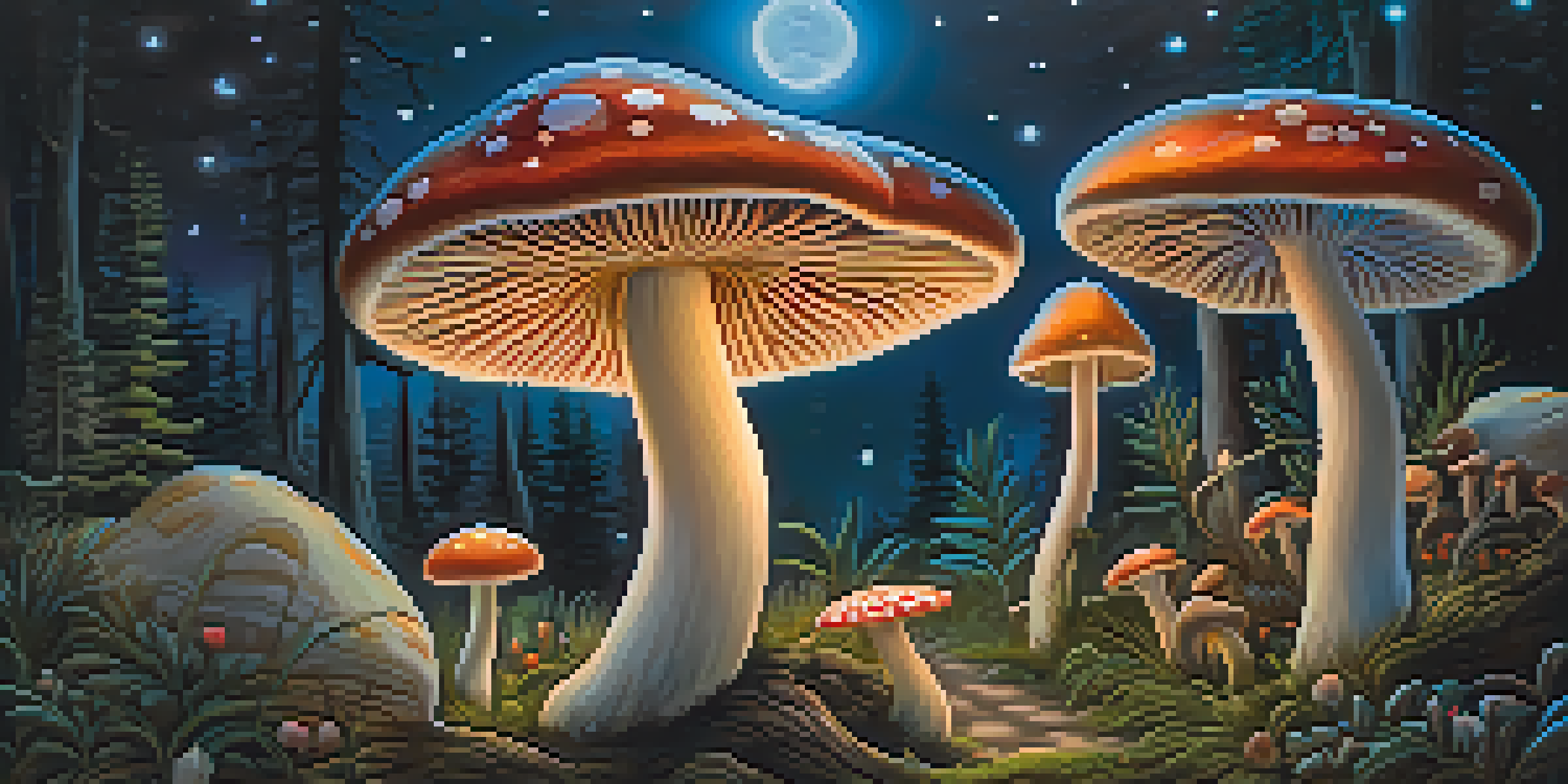Mushrooms and Metaphysics: Cinema's Take on Psilocybin

Understanding Psilocybin: The Magic of Mushrooms
Psilocybin, a naturally occurring compound found in certain mushrooms, is known for its psychedelic effects. When ingested, it converts to psilocin, which interacts with serotonin receptors in the brain, often leading to altered states of consciousness. Many people report profound experiences, including feelings of interconnectedness and spiritual insight, which can be likened to a journey into the self.
Psychedelics are a way to explore the depths of human consciousness and the mysteries of existence.
In recent years, scientific studies have begun to explore psilocybin's potential therapeutic benefits, particularly for mental health conditions such as depression and anxiety. This renewed interest has sparked a cultural conversation about the role of psychedelics in personal growth and enlightenment. Thus, it's no surprise that filmmakers are drawn to these themes, using cinema as a canvas to explore the depths of human experience.
This intersection of nature, science, and spirituality makes psilocybin a compelling subject in film. By showcasing the transformative power of mushrooms, directors invite audiences to contemplate their own realities. Through storytelling, they illuminate the metaphysical questions that arise when one delves into altered states of consciousness.
Cinema's Fascination with Psychedelic Experiences
Cinema has a long-standing fascination with altered states of consciousness, often portraying them as gateways to self-discovery. The visual medium allows filmmakers to create stunning representations of psychedelic experiences, utilizing vibrant colors, surreal imagery, and innovative editing techniques. This artistic freedom enables a deeper exploration of the effects of psilocybin on perception and reality.

Films like 'Enter the Void' and 'Fantastic Fungi' showcase how directors interpret the experience of psychedelics. These films often blend reality with dream-like sequences, leaving viewers questioning their own perceptions. This narrative style not only engages audiences but also encourages them to explore the philosophical implications of altered states.
Psilocybin's Therapeutic Potential
Recent studies highlight psilocybin's effectiveness in treating mental health issues like depression and anxiety.
Moreover, cinema often mirrors the societal attitudes towards psychedelics. As psilocybin gains attention for its therapeutic potential, films reflect a shift in perception, moving from stigma to acceptance. This evolving narrative in cinema serves to educate and inspire discussions about the transformative power of psychedelics.
Metaphysical Themes in Psychedelic Cinema
Metaphysics, the branch of philosophy that explores the nature of reality, is often a central theme in films that depict psychedelic experiences. These films encourage viewers to ponder profound questions about existence, consciousness, and the universe. For instance, characters experiencing psilocybin journeys may grapple with their sense of self, leading to revelations about their place in the cosmos.
The experience of psychedelics can foster profound insights into our connection with the universe.
A classic example is the film '2001: A Space Odyssey,' where psychedelic imagery invites viewers to contemplate the evolution of humanity and the infinite. Such films create a dialogue about the boundaries of human understanding, pushing audiences to consider the possibility of higher consciousness. This exploration of metaphysical themes resonates deeply with those who have experienced psychedelics firsthand.
Additionally, filmmakers often draw on spiritual traditions to enrich their narratives. By incorporating elements of Eastern philosophies or indigenous practices, cinema can present a holistic view of the psilocybin experience. This fusion of spirituality and psychedelia promotes a deeper understanding of the interconnectedness of all things.
Personal Transformation Through Psychedelic Journeys
Many films highlight the potential for personal transformation that can arise from psychedelic experiences. Characters often embark on journeys where they confront their fears, heal from trauma, or gain new perspectives on their lives. This transformative aspect resonates with audiences, who may see reflections of their own struggles and triumphs.
For example, in 'The Secret Life of Walter Mitty,' the protagonist's adventures lead him to confront his insecurities and embrace life fully. While not explicitly about psilocybin, the film captures the essence of personal growth often associated with psychedelic journeys. It emphasizes that such experiences can lead to greater self-awareness and fulfillment.
Cinema's Role in Psychedelic Dialogue
Films explore the transformative power of psychedelics, reflecting and shaping societal attitudes towards their use.
Moreover, these narratives often highlight the communal aspect of psilocybin experiences. Shared journeys can strengthen bonds between individuals, creating a sense of unity and understanding. This theme of connection is particularly poignant in films that depict group experiences, showcasing how psychedelics can foster empathy and compassion among participants.
Cultural Shifts: From Stigma to Exploration
The portrayal of psychedelics in cinema has evolved significantly over the years, reflecting broader cultural shifts regarding their use. Once relegated to the fringes of society, psilocybin is now being reconsidered as a legitimate tool for exploration and healing. This change is evident in recent films that tackle the subject with nuance and respect, rather than sensationalism.
Documentaries like 'How to Change Your Mind' delve into the science and history of psychedelics, fostering a deeper understanding of their potential benefits. By presenting well-researched information alongside personal stories, these films contribute to a growing acceptance of psychedelics in mainstream culture. Audiences are encouraged to approach the topic with curiosity rather than fear.
As societal attitudes shift, filmmakers are increasingly willing to explore the complexities of psilocybin use. This openness invites discussions about ethics, responsibility, and the transformative potential of psychedelics. Cinema serves as a mirror to society, reflecting our evolving relationship with these powerful substances.
The Visual Language of Psychedelic Films
The visual language used in psychedelic films is crucial in conveying the essence of psilocybin experiences. Filmmakers employ a range of techniques—such as vibrant color palettes, kaleidoscopic effects, and unconventional camera angles—to immerse viewers in altered states. This artistic approach helps to translate the often ineffable nature of psychedelic experiences into a visual format that resonates.
For instance, movies like 'The Last Shaman' utilize stunning cinematography to capture the beauty of nature and the surreal quality of altered perception. These visuals not only enhance the storytelling but also evoke the feelings of wonder and introspection commonly associated with psychedelic journeys. The result is a rich sensory experience that lingers long after the credits roll.
Metaphysical Themes in Film
Psychedelic cinema often delves into metaphysical questions, encouraging viewers to ponder existence and consciousness.
Moreover, the soundtrack plays an equally important role in shaping the viewer's experience. Music can evoke emotions and reinforce the themes presented on screen, guiding audiences through the highs and lows of a psychedelic journey. This combination of sound and visuals creates a powerful narrative that speaks to the heart of the psilocybin experience.
Future of Psilocybin in Cinema: What Lies Ahead?
As our understanding of psilocybin continues to grow, so too will its representation in cinema. With ongoing research highlighting its therapeutic potential and cultural significance, filmmakers are likely to explore these themes in new and innovative ways. This evolving narrative promises to engage audiences and spark conversations about the role of psychedelics in modern society.
We may also see an increase in diverse storytelling, with filmmakers from various backgrounds sharing their unique perspectives on psilocybin experiences. This inclusivity can enrich the narrative, providing a broader understanding of how different cultures interact with psychedelics. By showcasing a range of experiences, cinema can foster empathy and connection among viewers.

Ultimately, the future of psilocybin in cinema holds great promise. As filmmakers continue to push boundaries and challenge societal norms, they have the opportunity to reshape our understanding of these powerful substances. The journey into the world of mushrooms and metaphysics is just beginning, and audiences are invited to join in the exploration.